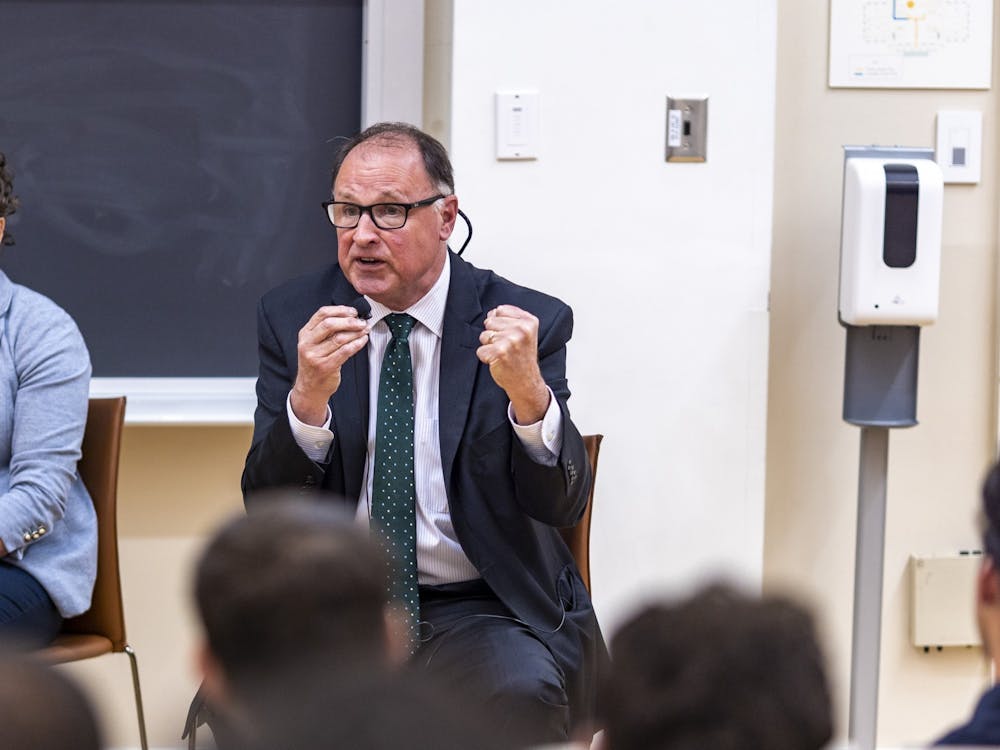As the University's Living Wage Campaign continues to simmer, similar campaigns nationwide have been making strides and receiving mixed reactions.
From social welfare advocates to conservative economists, the national campaign has evoked much thought - and produced two different ways of looking at the issue of a minimum wage for lower skilled workers.
The origins
The national Living Wage Campaign was a product of the 1990s and the brainchild of the grassroots, New York City-based New Party in conjunction with the Association of Community Organizations for Reform Now.
The Campaign won its first major victory in 1994 in Baltimore, when employers with Baltimore service contracts were required to provide a "living wage" of $6.10 an hour to their employees. The bill that passed the Baltimore living wage ordinance included steps to increase the wage to its current level of $7.70 an hour. over a four-year period.
New Party Communications Director Adam Glickman said Baltimore's success was the springboard for further Living Wage Campaigns and was born out of a sense of "growing inequality."
"More and more people were working two jobs and the minimum wage hadn't been raised in years," Glickman said.
Jen Kern, director of the national living wage resource center at ACORN, emphasized that the living wage is a concept, not a number, and has ranged from $6.70 to $10.75 an hour across the nation, depending on the cost of living in each city.
Kern said living wage rates are calculated by linking the wage level with the federal poverty level - which is $16,700 for a family of four.
"The movement insists that cities or counties or colleges - any public institution - should focus their limited tax dollars on businesses that create a living wage for its residents," she said. "In the absence of that, the city is making matters worse for families."
She added that with just a minimum wage, families often are relying on other venues for subsistence, including government resources such as food stamps and Medicaid.
"It's double-dipping," Kern said, adding that in this manner, the low minimum wage indirectly affects the tax payers' wallets.
Glickman emphasized the importance of self-sufficiency for minimum wage earners.
"A key point of our program is that we obviously think people working full time should be able to support their families and that large corporations should be accountable to their communities," Glickman said.
The Baltimore victory triggered campaigns in 42 other municipalities, including Milwaukee, Minneapolis, New York City, Portland, Jersey City, Chicago and Los Angeles County.
The University
At the local level, the University's Living Wage Campaign is an effort by the Labor Action Group - a group formed by faculty, staff and students in the spring of 1998 - to increase the current classified workers' wage from $6.13 an hour to a more "liveable" $8.
LAG members assert that a large portion of the University's classified workers live at or below the federally defined poverty level.
"It's unfair that people working at U.Va. should have to rely on social services in order to feed their families," said Susan Fraiman, a LAG member and English professor.
Since 1998, the wage rate has increased to $6.37, still below the $8 goal.
In its effort to enhance its presence and increase awareness, LAG has staged rallies and protests, distributed orange and blue "$8" buttons and last month it hosted a "Living Wage Live" concert in Old Cabell Hall that attracted a sold-out audience and raised about $6,000, Fraiman said.
She said LAG's goals for the future include further outreach to the workers affected by the Campaign and increased effort for worker involvement. But such mobilization sometimes can prove difficult.
"Mobilizing workers is very difficult. People are very wary and there is a problem with staff morale," Strawn said.
Charlottesville
The Charlottesville Living Wage Campaign passed through City Council last spring with relative ease because of the small number of city employees affected by the minimum wage increase. Charlottesville Vice Mayor Meredith Richards said while the city employs about 750 to 800 workers, only 19 city employees were affected by the raise to $8 - which did not cause a large dent in the city's budget.
"We are firmly behind the Living Wage Campaign," Richards said. "It was a matter of policy more than anything else."
City Councilman David Toscano said securing funds to supplement the wages of those earning below $8 was not as daunting a task as the University would face if it were to raise the classified staff's minimum wage.
The University now employs about 350 people who earn less than $8 an hour.
The office of Virginia Del. Mitch Van Yahres, D-57th, conducted a study of Charlottesville minimum wage policies. (See chart).
It took a hypothetical, single Charlottesville mother with one child and analyzed how she would survive on a weekly income based on an $8 an hour wage.
"At the end of the week ... she's $67 in the hole," Van Yahres said, explaining the costs of daycare, food and rent.
He said he supports the Living Wage Campaign at the University.
"I'm all for it," he added.
Economics and politics of wages
But a minimum wage increase does not come without strings attached.
Business groups say increasing costs will have adverse effects on workers - businesses will flee jurisdictions that require them to pay a living wage, or unemployment will increase as employers replace low-wage jobs with automated systems.
"Economists often say that you can't get a free lunch - the money is going to have to come from somewhere," said Diana Furchtgutt-Roth, resident fellow at the American Enterprise Institute, a Washington, D.C.-based conservative think tank.
Much of the debate about the living wage situation has centered around the "fairness" of employing people at just the minimum wage. Furchtgutt-Roth said emphasis instead should be placed on economic principles.
"There's been a lot written recently, not in terms of supply and demand, but about the fairness of certain wage policies," she said. "But looking at how much an employer pays as a matter of fairness might be a noble way of looking at it - but it doesn't accord with how our economic system works. [A living wage] is more in line with socialist systems used by the former Soviet Union - and this system didn't work for them and it won't work for us."
She added that limited financial resources would push employers to other venues if faced with raising wages.
"There are some jobs that aren't worth paying someone $8 an hour, and the result would be that fewer people will be hired for that job," Furchtgutt-Roth said.
But less conservative economic scholars said otherwise.
University Economics Prof. Edgar Olsen said a primary effect of raising wages is that an organization would be able to attract higher quality workers - a long-term effect that would be positive for the University.
"In my experience at the University, I think the University would gain by having higher quality workers among the low-paid workers," Olsen said.
This long-term effect would appear sooner if the rate of turnover in low-wage jobs at the University is high .
However, Olsen also said the quality of life for the poor is improved best by interventionist government programs like welfare rather than the actions of individual employers.
University administrators have said the University has no control over the Living Wage Campaign and cannot raise wages without approval from the General Assembly.
|
Subsisting on $8 |
|||
| For a typical employee earning the living wage of $8 an hour, expenses exceed earnings. |
|||
| INCOME | |||
| Hours Per Week | Per Hour Wage | Weekly Gross Income | Monthly Gross |
| 40 | $8 | $320 | $1,280 |
| EXPENSES | |||
|
Day Care Rent 2 Food Federal Taxes Utilities Clothes Health Insurance 3 Transportation |
Weekly 90 148.75 80 29.63 15 12 none 11.25 |
Monthly 360 595 320 118.52 60 50 45.00 |
Assistance unlikely 1 $178/month none |
| Total Deficit |
$387.13 $67.13 |
$1,548.52 $268.52 |
$178 |
| Source: Office of Del. Mitch VanYahres (D-57th) 1. Includes rent assistance 2. Charlottesville median rent, $595 per month 3. This family would not meeT the income requirements to qualify for Medicaid or Virginia Children's Medical Insurance Program. |
|||






